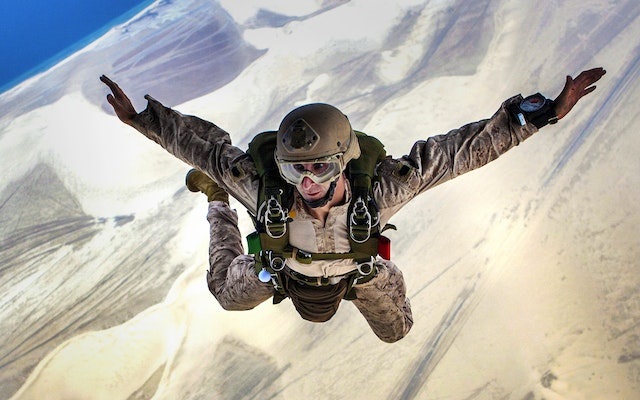
How much height does a parachute need? It completely depends on the type of parachute. We need to think about how long it takes a packed parachute to be released and inflate.
Parachutes are packed into the backpack they are carried in and they are usually made of nylon these days. They used to be round, but now they are rectangular and they have seven or nine cells which fill with air and inflate the parachute. Modern parachutes can be steered and even flared to make landing more comfortable. They have come a long way from early parachutes. When the parachute is packed into the backpack, it is folded so that the front of the cells come out first. Most modern parachutes don’t have a ripcord. A small pilot chute is connected to the bottom of the parachute pack and the skydiver releases this. The pilot chute rapidly fills with wind and pulls the rest of the parachute out of the bag. The cells on the parachute fill with air, inflating the chute, assuming everything goes correctly.
A parachute works because it balances out the forces of gravity and drag, or air resistance. Drag is the force encountered when trying to push something through air molecules. It takes energy to move the molecules out of the way and hitting the molecules slows down whatever is moving through them. This is why racing cars are shaped to avoid air resistance and why a bowling ball falls through the air faster than a feather. If you drop a bowling ball and a feather in a vacuum, they will fall at exactly the same speed. On Earth, without a vacuum, the air molecules push up and drag more on the feather than they do on the bowling ball. When something is falling towards Earth, gravity pulls it down and accelerates it, but the energy it needs to use to move the air molecules apart provides a brake. At some point, the drag will balance out the force of gravity and the falling object will stop accelerating, which is called terminal velocity. The terminal velocity for a person is about 200 km/h. However, if you can increase the surface area of an object without increasing its mass, it will encounter more air molecules and it will be slowed down even more, giving it a much lower terminal velocity. Parachutes reduce terminal velocity to about 20 km/h.
So, how much height does a parachute need? From when you release the pilot chute to the parachute completely deploying and stopping your freefall takes between three and five seconds. That sounds pretty fast, but if you are falling at terminal velocity you are going to cover about 50 meters every second. That is why most skydivers open their parachutes at about 2,000 m. The parachute takes about 150 to 200 m to open, and the skydiver can glide down the remaining 1800 m. The reason for this height is to give the skydiver enough time to react and deal with the problem should the first chute not open properly. More experienced skydivers could probably open their chutes closer to the ground because they would be able to deal with the problems faster, but nobody really does because the risks are too great.
The 3 to 5 seconds needed to open a parachute obviously varies greatly with the size of the parachute, the way it is packed, the weight of the person parachuting, and even the weather conditions. All of these things have to be taken into consideration. Tandem parachute jumps take the longest time to open because there is the weight of two people. Military parachutes can also take a longer time to open because of all the equipment they will be carrying.
3 to 5 seconds is the time required if someone is falling at terminal velocity. A parachute can inflate much more quickly if the person is falling at a slower speed. BASE jumpers often jump from low structures and the lowest ever BASE jump was 32 meters. A British BASE jumper jumped from the Whispering Gallery inside St. Paul’s Cathedral. BASE jumpers use a number of techniques to get the parachute out and inflated faster. The first is to use a much larger pilot chute, which pulls the main chute out with more force. The second, in situations where the jump is extremely low, is to have a person hold onto the pilot chute and physically pull the parachute out of the jumper’s backpack as they fall. BASE jumpers also use larger chutes, which catch more air, produce more drag, and slow them down more quickly. BASE jumpers also don’t carry a reserve parachute because if something goes wrong with the first one, they wouldn’t have any time to do anything about it. A BASE jumper parachute could theoretically be opened in under 30 meters, but somebody would have to be either very brave or very stupid to test it. And this is what I learned today.
Photo by Pixabay: https://www.pexels.com/photo/military-man-skydiving-37656/
Sources
https://www.theguardian.com/science/2003/may/15/thisweekssciencequestions2
https://www.technicaltextile.net/articles/an-overview-of-parachute-fabric-7170
https://www.explainthatstuff.com/how-parachutes-work.html
